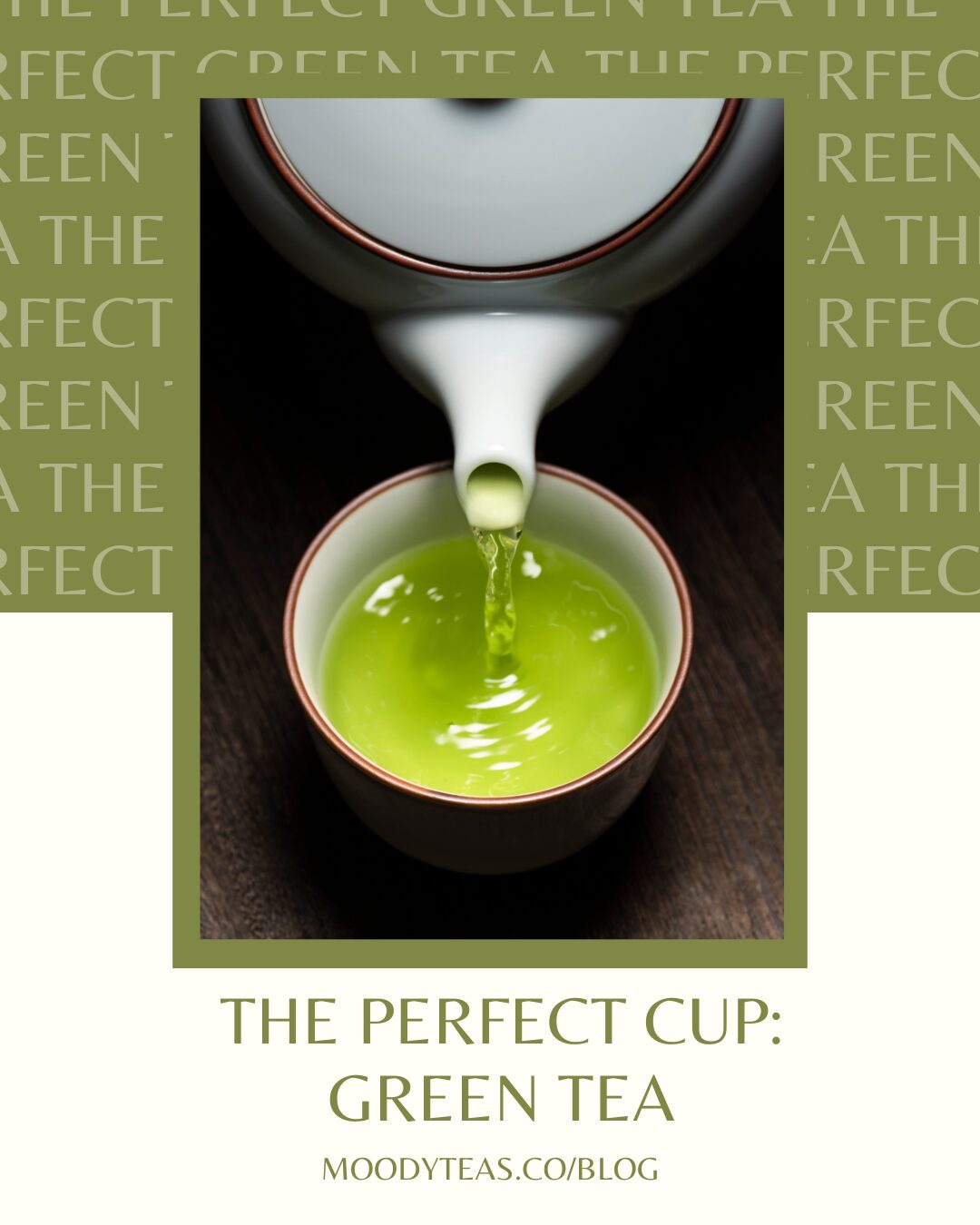Have you ever taken a sip of the green tea you just brewed only to find it was bitter and tasteless? Today we’re learning all about green teas and how to brew the perfect cup!
Green tea is a type of tea that is made from Camellia sinensis leaves and buds that have not undergone the same withering and oxidation process as black tea and oolong tea. This results in a lighter, more delicate flavor and color than other types of tea. Green tea is a popular beverage in many parts of the world, particularly in Asia where it has been consumed for centuries for its various health benefits. It contains a range of natural antioxidants and other beneficial compounds that are believed to provide health benefits, such as reducing the risk of certain diseases and aiding in weight loss. Green tea is also available in many different varieties, each with its own unique flavor and aroma.
The History of Green Tea
Green tea is believed to have originated in China thousands of years ago. Legend has it that tea was discovered by the Chinese Emperor Shennong, who was said to have discovered the healing properties of tea when some tea leaves accidentally fell into his pot of boiling water.
Over time, green tea became an important part of Chinese culture and was used for its medicinal properties. It was believed to have a calming effect on the mind and body, and was often used in traditional Chinese medicine to treat a variety of ailments.
Green tea was introduced to Japan by Buddhist monks who traveled to China and brought back tea plants and knowledge of how to prepare and brew tea. In Japan, green teas became an integral part of Japanese culture, and the tea ceremony, or cha-no-yu, was developed as a way to honor and appreciate the beauty and simplicity of tea.
Today, green tea is grown and consumed all over the world, and is known for its health benefits and unique taste. It is made from the leaves of the Camellia sinensis plant, which are steamed or pan-fried to prevent oxidation, resulting in a tea that is high in antioxidants and other beneficial compounds.
Growing Green Tea
Green tea is grown in many different parts of the world, including China, Japan, India, Sri Lanka, and Kenya. The method of cultivation can vary depending on the location and the specific variety being grown, but there are some general principles that are commonly followed.
The Camellia sinensis plant is typically grown in areas with mild temperatures and well-drained soils. The plants require plenty of sunlight, but not direct sunlight for long periods of time. In some regions, such as in Japan, the plants are grown under shade to increase the chlorophyll content and enhance the flavor of the tea.
Tea plants are typically grown from cuttings rather than from seeds. The cuttings are planted in rows, and are pruned and shaped to promote healthy growth and to allow for easy harvesting of the tea leaves.
Depending on the variety of tea being grown, the leaves are typically harvested two to three times per year. The first harvest, which is known as the first flush, produces the highest quality tea leaves, as they are the youngest and most tender. Subsequent harvests may produce leaves that are larger and coarser in texture.
Processing Green Teas
Once the tea leaves are harvested, they are typically steamed or pan-fried to halt oxidation and preserve their green color and delicate flavor. The leaves are then rolled and dried before being packaged and sold as loose leaf tea or tea bags.
Green tea is made by harvesting fresh leaves from the Camellia sinensis plant and then quickly processing them to prevent oxidation. The specific methods used for processing green teas can vary depending on the region and the particular variety of tea being made, but there are some general steps that are typically followed.
- Withering: The freshly harvested tea leaves are spread out in a thin layer and left to wither for several hours. This helps to remove excess moisture from the leaves and prepare them for the next stage of processing.
- Heat treatment: To halt the oxidation process and preserve the green color of the leaves, they are typically subjected to a heat treatment. This can be done in several ways, including steaming, pan-frying, or baking. In Japan, steaming is the most common method, while in China, pan-frying is more commonly used.
- Rolling: Once the leaves have been heated, they are typically rolled or shaped into tight curls or twisted shapes. This helps to break down the cell walls in the leaves and release the flavor compounds.
- Drying: The rolled leaves are then dried to remove any remaining moisture and ensure that they are shelf-stable. This can be done by air-drying or by using a machine to apply heat.
- Sorting and packaging: Finally, the dried leaves are sorted by size and quality, and then packaged for sale as loose leaf tea or tea bags.
Overall, the processing of green tea is designed to preserve the delicate flavor and aroma of the fresh leaves, while also maximizing their health benefits. The precise methods used can vary depending on the region and the tea maker’s preferences, but the basic principles remain the same.
Types of Green Tea
There are many different types of green tea, each with its unique flavor profile, aroma, and appearance. The specific type can be influenced by factors such as the region where the tea is grown, the time of harvest, and the processing method used. Here are some of the most popular types:
- Sencha: Sencha is one of the most popular green teas in Japan and is made from the first or second flush of tea leaves. The leaves are steamed and then rolled into thin, needle-like shapes. Sencha has a bright green color and a fresh, grassy flavor.
- Matcha: Matcha is a powdered tea that is made by grinding shade-grown tea leaves into a fine powder. The tea is typically whisked with hot water to create a frothy, smooth beverage. Matcha has a strong, distinctive flavor and is often used in Japanese tea ceremonies.
- Dragonwell: Also known as Longjing, Dragonwell is a tea from China that is known for its delicate, nutty flavor. The leaves are flat and smooth, with a distinctive pointed shape.
- Gyokuro: Gyokuro is a high-quality green tea from Japan that is made from shade-grown tea leaves. The leaves are picked by hand and then steamed and rolled. Gyokuro has a sweet, mellow flavor and a pale green color.
- Gunpowder: Gunpowder is a tea from China that is named for its tightly rolled leaves, which resemble gunpowder pellets. The leaves are typically pan-fired, which gives them a smoky flavor and a deep green color.
- Bancha: Bancha is a lower-grade tea from Japan that is made from the later flushes of tea leaves. The leaves are typically roasted, which gives them a slightly nutty flavor and a dark green color.
- Jasmine: Jasmine green is made by blending green tea leaves with jasmine flowers, which gives the tea a delicate floral aroma and flavor. The leaves are typically hand-rolled into small balls or pearls.
- Mao Feng: Mao Feng is a type of tea from China that is made from the young, tender leaves of the tea plant. The leaves are picked in the spring and then steamed and rolled. Mao Feng has a fresh, vegetal flavor and a delicate aroma.
- Shincha: Shincha is a type of green tea from Japan that is made from the first flush of tea leaves. The leaves are hand-picked and quickly steamed to preserve their fresh, grassy flavor. Shincha is only available for a short period each year, typically in the spring.
- Houjicha: Houjicha is a roasted tea from Japan that is made from the leaves and stems of the tea plant. The tea has a nutty, smoky flavor and a light brown color. The roasting process also reduces the caffeine content of the tea, making it a good choice for those who are sensitive to caffeine.
- Ceylon green tea: This is a type of tea from Sri Lanka that has a brisk, bright flavor and a light golden color. The leaves are typically steamed and then rolled before being dried.
These are just a few examples of the many types of green tea that are available. Each type has its unique characteristics and is well-suited for different tastes and preferences.
Health Benefits
Green tea has been studied extensively for its health benefits, and it has been found to contain a variety of compounds that can have positive effects on the body. Here are some of the potential health benefits of:
- Antioxidant properties: Green tea is rich in antioxidants called catechins, which can help to protect the body against damage from free radicals. This can potentially reduce the risk of chronic diseases such as cancer and heart disease.
- Improved brain function: Green tea contains caffeine and a compound called L-theanine, which can work together to improve brain function and boost cognitive performance.
- Reduced risk of heart disease: Drinking green tea may help to reduce the risk of heart disease by improving cholesterol levels, reducing blood pressure, and improving blood vessel function.
- Weight loss: Green tea has been shown to increase metabolism and promote fat burning, which can potentially help with weight loss.
- Reduced risk of cancer: Some studies have found that green tea consumption may be associated with a reduced risk of certain types of cancer, including breast, prostate, and colorectal cancer.
- Improved dental health: The catechins in green tea can help to prevent the growth of bacteria that can cause dental cavities and gum disease.
It’s important to note that while green tea has been shown to have potential health benefits, it should not be considered a cure-all or a replacement for medical treatment. It’s always best to talk to your healthcare provider before making any changes to your diet or lifestyle.
Brewing Methods
Brewing tea properly is important to bring out its unique flavor profile and to maximize its potential health benefits. Here are some general guidelines for brewing green tea:
- Use high-quality water: The quality of the water you use can impact the taste of the tea. Use filtered water or spring water for the best flavor.
- Choose the right temperature: Green tea is delicate and can be easily over-steeped, which can result in a bitter taste. The water temperature should be around 175-185°F (80-85°C). You can achieve this by boiling water and then letting it cool for a few minutes before brewing.
- Use the right amount of tea: A general rule of thumb is to use one teaspoon of loose tea per cup of water. However, the specific amount may vary based on the type of tea and your personal taste preferences.
- Steep for the right amount of time: Green teas should be steeped for 1-3 minutes, depending on the specific type of tea and your personal taste preferences. Steeping for too long can result in a bitter taste.
- Strain and enjoy: Once the tea has steeped for the desired amount of time, strain the tea leaves.
Overall, the best way to brew is to experiment with different brewing methods and find what works best for you. Pay attention to the water temperature, steeping time, and amount of tea used to achieve the perfect cup of green tea.
Can you gong fu?
Yes, you can certainly use the gong fu brewing method for green teas. Gong fu brewing is a traditional Chinese tea brewing method that involves using a small teapot and brewing the tea in several short, successive infusions to bring out the full flavor of the tea.
To brew using the gong fu method, follow these steps:
- Heat the water to the appropriate temperature. For most green teas, the water temperature should be around 175-185°F (80-85°C).
- Preheat your teapot and cups by rinsing them with hot water.
- Add a small amount of loose leaves to the teapot. The exact amount will depend on the size of your teapot, but a good rule of thumb is to use enough tea to cover the bottom of the pot.
- Add hot water to the teapot and immediately pour it out to rinse the tea leaves.
- Add more hot water to the teapot and steep the tea for a short amount of time, usually around 15-30 seconds.
- Pour the tea into small cups and enjoy.
- Repeat the steeping process for several more infusions, gradually increasing the steeping time for each infusion.
Using the gong fu brewing method can bring out the full flavor and aroma of the tea and allow you to appreciate the subtle nuances of different green tea varieties.
Can you brew green tea iced?
Yes, green tea can be served iced, and it makes a refreshing and healthy beverage during hot weather! Iced tea is a great alternative to sugary soft drinks and can help you stay hydrated during hot weather.
Can you cold brew green tea?
Yes, you can cold brew green tea. Cold brewing is a simple and popular method for making iced tea because it requires less effort and produces a smoother, less bitter flavor.
What else would you like to know about green tea? What are some of you favorite green teas? Let us know in the comments below!






